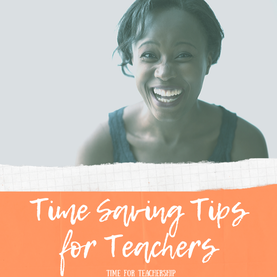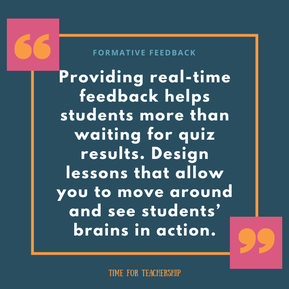|
One of the biggest struggles for educators is not having enough time. I want to acknowledge that this is a systemic problem—our educational systems are designed in a way that perpetuates burnout, and this should change. However, until that change happens, I want to share some time saving tips that have helped me make space for the stuff that re-ignites my passion for teaching. Below, I share two time savers for planning and two for grading. Shift your planning goal from “covering content” to developing independent learners. So much of my own stress came from not being able to cover all of the content. I talk more about this as one of the big planning mistakes I made as a teacher in a previous post. Simply acknowledging you will not “get through” content frees up your class time. I find when I am using terms like “cover content” and “get through,” the students aren’t retaining what I want them to anyways. It’s better to focus on doing less, but make sure students are actually learning it. I will be posting an entire blog on this topic next week, but I’ll give you the short version here. The world is changing. Things are Google-able. It’s more important students are able to find, analyze, and apply new information than memorize a predetermined list of facts. Students are more engaged when they are given choices for how to connect content with their own lives, when they are challenged by assignments that have an authentic purpose, and they are able to set and reflect on their own goals for learning. This can’t happen when we try to simply “cover” content. This may be how we learned, but it’s just not preparing our kids for the kind of world they will (and currently do) live in. Select a few low-prep, high-impact strategies and recycle them. Students and teachers benefit from routine. Think of the best class you’ve ever had, where students were most engaged. What was the activity? What were students doing during the lesson? If you need help generating this list, you may find the strategy from this post helpful. Make a list of 3-5 activities or protocols. For example, my top 3 discussion protocols are: circle, socratic seminar, and human barometer. Once you determine what kinds of activities you want students to engage in (e.g., discussion, analyzing text, creative application), list out a couple of protocols that you and your students like to engage with. Bonus points if the activity itself is low-prep and you just need to substitute content-specific text/questions. Keep this protocol bank, and recycle activities each week or unit. If you find yourself spending hours making mini lessons ask yourself: How could I teach the same content and have the students practice a different skill than listening and note-taking? For example, my transition from lecture prep to student-centered instruction started with this time saving shift: read through a textbook, make a slide deck, and create a guided worksheet (~4 hours) → find a text(s), generate 1-2 big questions to answer, and choose a text-based protocol from my resource bank (~30 minutes). My planning was easier and my students were developing text analysis skills. Use tech to speed up grading. As a humanities teacher, one of the biggest drains on my time was grading papers and providing detailed feedback. If you teach math, your time may be spent grading quizzes or exit slips. I have time savers for both! Technology saved me a ton of time grading quizzes and exit slips. Google Forms (or similar apps through your school’s Learning Management System) is what I used for grading multiple choice assessments—quizzes or exit slips. You can input the correct answers into a form and set it to auto-grade. This way, students receive immediate feedback and as a teacher, I can visually pull up pie charts of how students did in real-time, and re-teach before students leave class, as opposed to the next day. This saves you time and improves student retention of accurate information. My paper grading also benefited from technology. Google Docs is helpful for adding comments to student work. I’ve used both typed and audio notes when my hands were tired of typing or I could talk faster than I could type. I used Vocaroo for this and pasted the link into a Doc comment. I’ve also found screen recording to be an excellent way to grade—I can verbally share my comments as if we were in a 1:1 conference while I point to the sections of the paper I’m referring to because I’m recording my screen. For more time saving tech tools, get my freebie! It includes a list of 5 Chrome extensions I use to save time planning lessons, grading assignments, and communicating with students and parents. Grade during class. Formative assessments are great for advancing student learning. Summative assessments are often heralded as the best form of assessment, but the formative assessment leading up to the summative is where the growth happens. Formative assessments may be quizzes or exit tickets, but it could also be listening to students discuss or watching how they approach and solve a problem. Being able to provide real-time feedback is going to help students more than waiting to see how they did a week later on a quiz. Design lessons that allow you to move around and see students’ brains in action. You can also provide feedback on more formalized assessments in class. Let’s say students just submitted their first draft of a paper. As you read through these first drafts, I challenge you to write just one phrase of feedback. The goal in this is to identify the most important, highest-leverage piece for students to revise. As you identify these for students, it’s likely you will notice a few categories that are repeating. You can use Micro-Grouping to give students focused feedback in small groups as opposed to writing the same comments on each individual paper. Again, this saves you time and is better for student learning since they can ask questions about your comments in real-time. Many of these tips require a re-thinking and re-working of how we currently do things. That’s a necessary part of saving time. We can’t create it out of thin air, so we need to give something up. It’s just a matter of evaluating what is worth keeping and what is worth switching up. These are just 4 starting points. I hope these tips help you start thinking about ways to carve out more time for the important things. Interested in more time saving ideas? Angela Watson’s Truth for Teachers podcast offers some excellent tips and shares success stories from teachers who have saved themselves lots of time! I’d love to hear what else you’ve found saves you time. Share your tips with other educators or ask the community on our facebook group. Go get that time back, teachers!
0 Comments
Leave a Reply. |
Details
For transcripts of episodes (and the option to search for terms in transcripts), click here!
Time for Teachership is now a proud member of the...AuthorLindsay Lyons (she/her) is an educational justice coach who works with teachers and school leaders to inspire educational innovation for racial and gender justice, design curricula grounded in student voice, and build capacity for shared leadership. Lindsay taught in NYC public schools, holds a PhD in Leadership and Change, and is the founder of the educational blog and podcast, Time for Teachership. Archives
May 2024
Categories |





 RSS Feed
RSS Feed